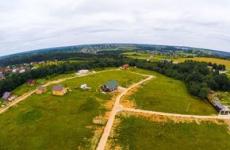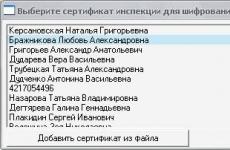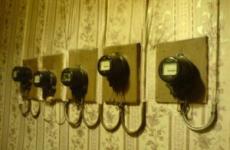Television antenna for the apartment. Digital antenna or which antenna to choose to give.
“Antenna for digital TV - your pass to the world of the perfect picture” - “The key to free TV” - This is exactly the way advertising slogans of television and online stores sound and this is not a hoax! But the trouble is that this is the whole truth and ends! What am I talking about?
Hello!
In touch the author of this site, Vitaly Lebach. And what motivated me to write this article? It can be said, the desire to warn its readers about the deception which is actively promoted on the wave of the spread of digital television. And also, the indignation of the arrogance of some sellers who buy goods to people that are not worth their money, obviously deceiving and misleading.
Honestly, after looking at the advertisement of this antenna, I thought “Oh well! Nobody will lead to this. ”- But I was mistaken, however, and understandably, people invest a lot of money in advertising. Before this, various tests are carried out, texts and slogans are selected in general, they do everything that a knowledgeable person would say “Wow-WANT” and ran to spread his money.
The key to free tv
First, advertising has tumbled down from the TV screens.
By the way, this antenna looks like this - this is not necessarily the one that advertises, there are many of them. But the concept of the antenna is such a Ring and Mustache. The latter, by the way, are not at all necessary for digital TV, as the whiskers are designed to receive the meter-wave, and the digital signal goes in decimeter.
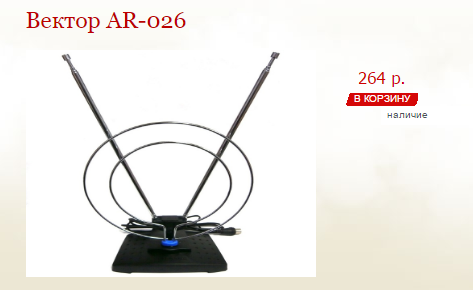
A store on the couch offers an antenna positioning it as “The Key to Free TV” - and there’s some truth in it, indeed Digital Terrestrial Television is absolutely free. Already as much as 20 television channels and 3 radio stations.
AND EVERYTHING, guys EVERYTHING! Twenty and three - And not a hundred or two hundred, and for the majority of the audience of 20 - enough. And in some places there are not even 20 yet, only 10 are being broadcast. digital channels.
Perhaps in the future, when the radio frequencies are released, due to the large-scale implementation of DTV - there will be an opportunity for another package of free channels
But why shout that with this miracle antenna it is possible to watch over a hundred digital channels?
Why bring this antenna in such a way that it’s enough to buy only one and that’s it! And free, numerous, digital channels will appear on your televisions. And the fact that most people do not have a DVB-T2 tuner on TVs and this antenna will be useless, not a word.
Since I am engaged in television, antennas and the like, people began to ask me to give them the opportunity to purchase this wonderful antenna! I explain to them that this is all a hoax, no need to buy an antenna for 2999 rubles.
But the power of advertising is great! And even my authority in the field of antennas is not always able to destroy it.
Yeah, some buyers think ... If it did not work out for you, I will buy it in the TV store!
Time passes! They come - “She doesn’t catch anything, I called them, they said send her back to us, we will return the money” Well, at least that’s what it is. Although in this I have doubts. If they all start to accept returns ……. well you understand!
And was it worth bothering! When the antenna, really working costs three or even four times cheaper.
Well, who needs it? It does not twist on TV, it just offers a person who is engaged in the installation and configuration of antennas, and this is not our level! Give us the one from the advertisement!
Although what did I get on this antenna? A normal antenna will even work in conditions of a good signal, and since the signal of digital TV is already high in many regions, and this trend will develop, then it will work for many. Sellers are counting on this.
Well, the fact that its real price does not exceed 1200 rubles (And this is the retail price for such an antenna) - Here is an example of such a proposal.
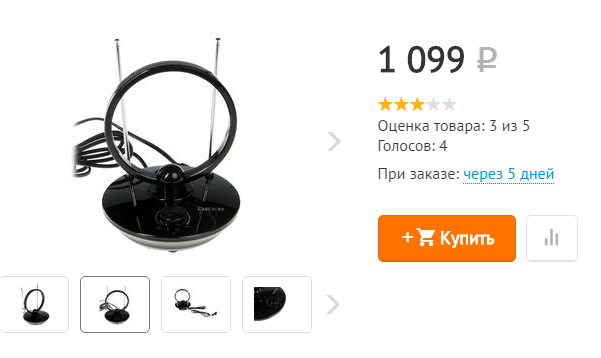
The fact that it is possible with a much better result to use an antenna of a different design, costing three times cheaper. So who cares!
The most powerful antenna for digital TV - your passport to the ideal world of TV pictures - Aerial 2100 Antenna
With no less cynicism, Internet sellers have also been brought to the point. Stumbled upon one such site.
I propose to consider in more detail their proposal, so to speak in pictures, admire, but do not buy!

The fact that no ripples, clear and stable image, it is true! Digital television is capable of this. But not always with the antenna that they offer. The fact that more than 100 channels - outright lies! 20 channels - everything! Well, only in some regions it can be a little more at the expense of non-state television channels or, for example, in cities bordering Ukraine or other nearby states, you can catch their digital TV channels.
The phrase "Perfect for plasma TVs" kills altogether, explaining why.
The fact is that when the plasma was produced, the DVB-T2 format was not there yet, and therefore the plasma TV was not equipped with an appropriate tuner and would not catch the figure without an external set-top box. So not perfect. But even that is not all.
Just a few days ago, repaired plasma tv samsung with a diagonal of 50 inches. Eating 450 watts of infection! So, this TV when connecting a set-top box to it via an HDMI input, reports “Not Available Format”.
I had to translate the console in more low quality 720P video signal So there is no talk about HD quality using plasma! Outdated technology understand!
Further, about this "wonderful" offer!
Sellers use strong motivation! Why pay for 100+ channels of satellite TV when you can watch 100+ for free on this antenna! Nor do you need to spend much on satellite equipment! I bought only one antenna and that's it! Beauty!!! But the truth is deceptive!
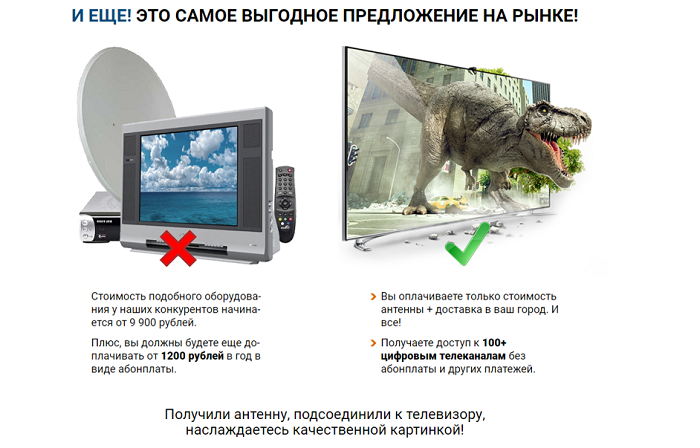
Where no reviews from "grateful customers", without them can not do! Read what they write. A certain Sergey mentions the plasma, and above you could read my point of view about this. Gregory enjoys low cost!

And really! How much is this miracle? Let's get a look!

Wow discount! We must take! Two, no three antennas!
Well, at the finals the most interesting, but what kind of antenna!? PaaBaaM !!! There should be fanfare!
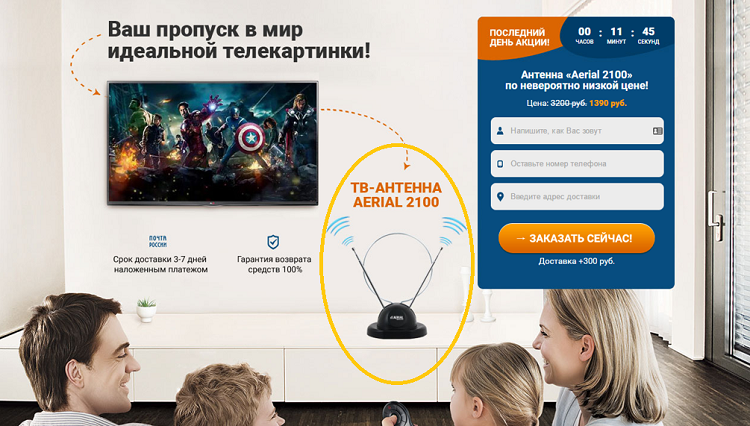
Just stunned !!! Nothing like ??? Look below! And compare prices. I assure you, these are antennas as from one field of a berry!

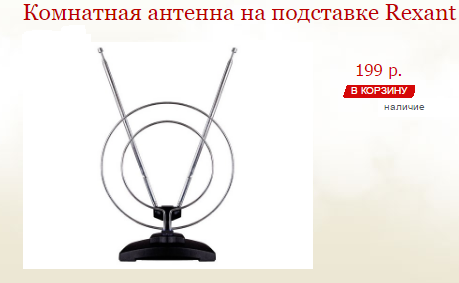
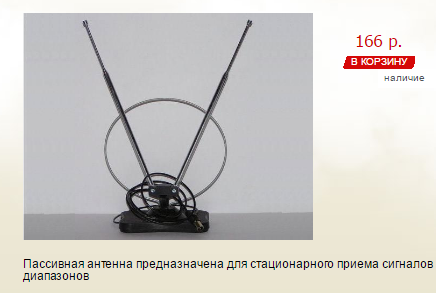
And again, I will say that if you live near the tower, even such an antenna will receive 20 channels of digital TV.
But not for 1390 rubles! Yes, plus 300 p. for delivery!
With the same success, you will be able to bend a ring of wire by taking a sample of the desired diameter of two to three-liter jars, and connect a television cable to the ends of this non-closed ring. The central core is at one end, and the screen at the other is all! The effect will be the same. And it will work in the zone of confident signal reception. Believe my experience!
Antenna key to free tv, reviews
By the way, I specifically went to several sites for reviews, and once again made sure- People earn extra money by leaving feedback on everyone ........ think further on yourself! In general, these "left" reviews!
Especially impressed with the pearl from the "Former employee" of the company Tricolor. This is just a masterpiece of technical illiteracy! At first I thought, maybe he worked there as a janitor, but no, I installed the equipment! Meet the most "delicious" highlighted. And people believe this ??? Alas, Yes!
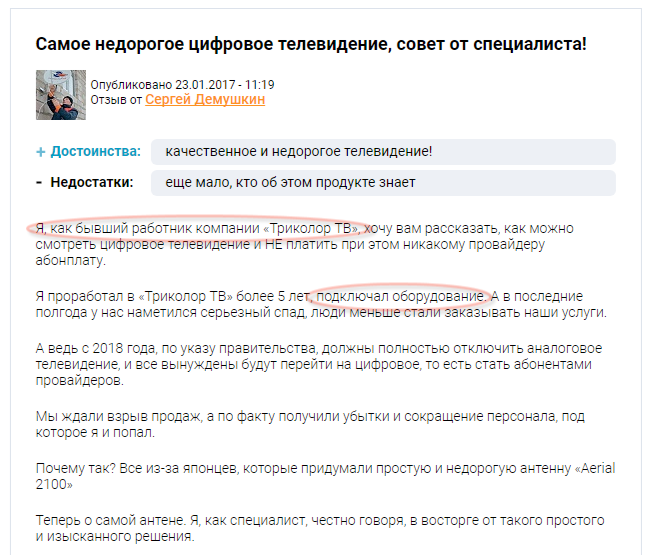
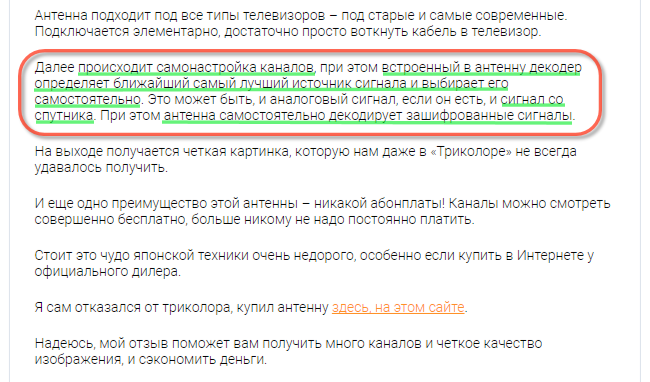
Here are a few more, but against the background of the above, this is already so, too gray!
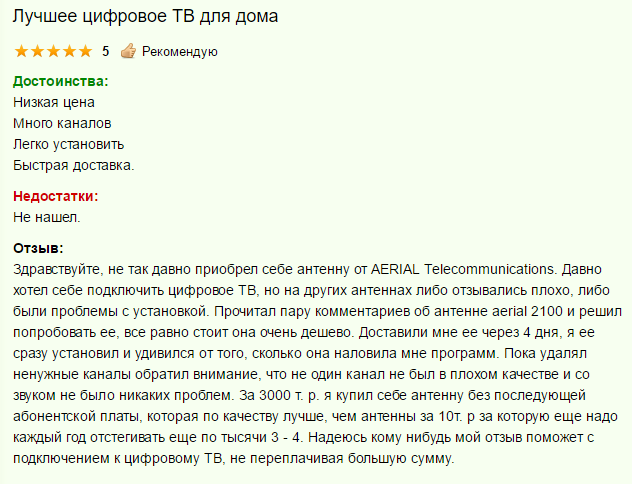

These are the cakes ... ..
Want to know the real situation with digital tv antennas? Then look here these articles on my site.
That's all! Do not allow yourself to be deceived in such a brazen manner!
It will be mutually beneficial, for your friends and for my blog. Thank!
P.S. I noticed that in this article appears advertising these same antennas.
Guys! As the saying goes, “I'm not guilty! He came! ”))) - Advertising is automatically selected according to your search queries!
Frequently, customers coming to our store say: “I need a prefix for 20 channels, otherwise my neighbor has some kind of bad one. It shows only 10 channels.. I think from the above, you already understood that the number of received digital television channels does not depend on the DVB-T2 receiver model and its prices.
Of course, based on the experience and statistics collected by us, it cannot be argued that all receivers, regardless of the “stuffing”, process a weak on-air DVB-T2 signal equally well. However, it is safe to say that the quality of the received digital signal depends entirely on your television antenna. And yet, strange as it may seem, both from the TV cable and the quality of its cutting.
Thus, if with television reception everything is more or less clear and relatively simple in the city, in order to enjoy watching your favorite TV shows in the country, you should carefully select the antenna that will be able to provide high-quality reception of the on-air DVB-T2 signal in this particular place. And the choice will largely depend on the location of the nearest translator, the signal of which will be “caught” by the antenna.
Antennas for terrestrial digital television.
In general, on-air television broadcasting is conducted on meter (MW / VHF) and decimeter (UHF / UHF) waves. To receive channels in digital format DVB-T2, enough antenna, which is able to operate in the decimeter range. Moreover, the digital antenna is no different from the usual, and the inscriptions on the boxes like: "DVB-T2 antenna", "Digital TV Antenna", "Antenna for digital television" etc. - normal advertising move. Many already have full-wave TV antennas at their dachas, they may well be suitable for receiving an on-air digital television signal.
Everyone knows that the antennas are indoor and outdoor, active (with an amplifier) and passive, purchased and homemade. Make recommendations for making homemade antennas not in my competence and the task of this article. Here we look at antennas that you can buy in our store.
Room antennas for DVB-T2 signal reception.
 UHF indoor antennas are very compact and there is nothing strange in the fact that in the country many people want to use just such antennas. Firstly, it is not noticeable, in the winter they “do not cut” like a Christmas tree before the New Year. Secondly - no need to climb on the roof, install the mast, and indeed, a minimum of efforts to secure such devices. But the reception feature at the dacha is that the DVB-T2 translator can be thin and at the same time be located far enough, and sometimes also a house in a valley. What kind of room antenna. Reception to it is possible only in the zone of reliable reception, where the level of the on-air digital television signal will be quite high.
UHF indoor antennas are very compact and there is nothing strange in the fact that in the country many people want to use just such antennas. Firstly, it is not noticeable, in the winter they “do not cut” like a Christmas tree before the New Year. Secondly - no need to climb on the roof, install the mast, and indeed, a minimum of efforts to secure such devices. But the reception feature at the dacha is that the DVB-T2 translator can be thin and at the same time be located far enough, and sometimes also a house in a valley. What kind of room antenna. Reception to it is possible only in the zone of reliable reception, where the level of the on-air digital television signal will be quite high.
Those who wish to use a house antenna at the dacha, as hunting is sometimes more difficult for captivity, can be given quite universal advice:
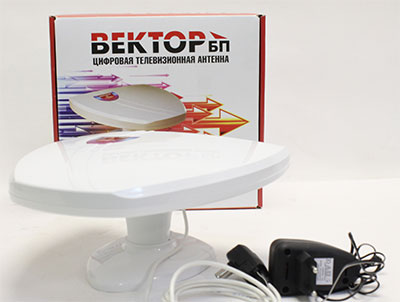 If a translator is visible from your or your nearest summer cottage, even from the roof of the house, you can try connecting a receiver to the DVB-T2 instead of an antenna, for example, a piece of wire or coaxial cable. Select an item in the console menu "Manual Settings" channels and set the desired channel (this process is described in any of the reviews of receivers on our website). Then, walk around the room with this wire antenna, for example, bring it closer to the window, try to raise it higher to the ceiling, transfer all the “equipment” to the attic, etc. If there are at least some minimum more or less clear, and even more desirable - stable readings of the scales "Power" and / or "Quality", then you can try a directional active (with an amplifier) indoor antenna. With a high degree of probability, it will “work”.
If a translator is visible from your or your nearest summer cottage, even from the roof of the house, you can try connecting a receiver to the DVB-T2 instead of an antenna, for example, a piece of wire or coaxial cable. Select an item in the console menu "Manual Settings" channels and set the desired channel (this process is described in any of the reviews of receivers on our website). Then, walk around the room with this wire antenna, for example, bring it closer to the window, try to raise it higher to the ceiling, transfer all the “equipment” to the attic, etc. If there are at least some minimum more or less clear, and even more desirable - stable readings of the scales "Power" and / or "Quality", then you can try a directional active (with an amplifier) indoor antenna. With a high degree of probability, it will “work”.
If the active indoor UHF antenna is used near a fairly powerful translator, for example, within the city, then it would be better if gain control option. A too strong signal for a DVB-T2 set-top box is as bad as a weak one.
The statement that in the city you can catch a digital TV signal even for a nail is fundamentally wrong. Each specific location of this “receiving nail” will be unique in terms of the conditions of admission. Even the antenna, and that has to pick up.
Hit 1. Perhaps the best indoor antenna to work with the reflected signal, in difficult urban environments.
Video review antenna Delta 131A.03 - 5c
Video review antenna Delta 131A.02 - 5c
Indoor antennas, undoubtedly, have many advantages, but, nevertheless, most often it happens that with all the manipulations with them in the conditions of the summer cottage no signs of a clear reception of the on-air digital DVB-T2 signal can be achieved. In this case, without an outdoor antenna will not do. And for options, when the distance to the nearest translator is tens of kilometers, an external antenna is definitely required.
And the main question here will sound like - which one?
Most likely, you will not be the only owner of a DVB-T2 receiver in your gardening. Take a closer look at the antennas in the neighboring areasto where they are directed. If there is such an opportunity, then talk to the hosts, find out how their works. digital set-top box with such an antenna. This will certainly help to make a choice.
Outdoor antennas for DVB-T2 signal reception.
As a rule, the following questions arise when choosing an outdoor antenna:
- Which antenna is best suited for receiving digital TV signal in the country?
- Which is better - passive or active?
- Where is better to install the antenna?
- Which cable to choose?
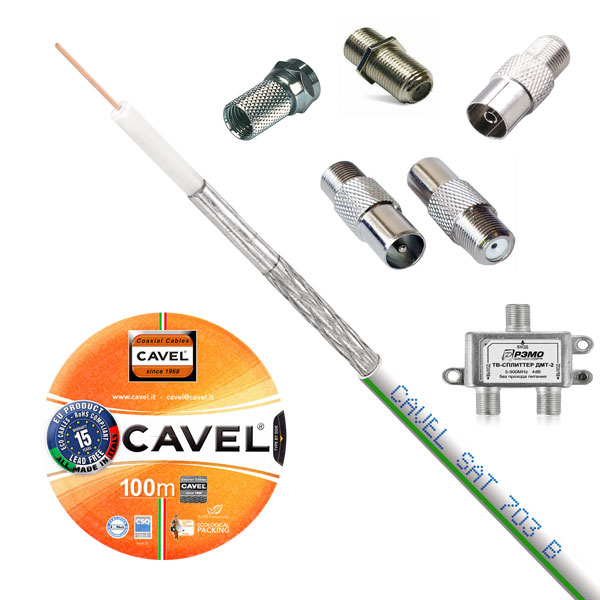 Unfortunately, the exact answer, which will be fair in all cases, can only be given to the last question. The cable must be of high quality. You should not save on it, since a bad cable will bring to nothing all the advantages of even the best antenna. The central core should be thick and soft, the screen should consist of foil and copper, preferably tinned, braid, and not just foil. By the way, the highest quality cables use double foil, i.e. foil film foil. The cable diameter must be at least 5 millimeters. The easiest way is to find fittings for a 6 mm coaxial tv cable. And yet, about which cable is better to use and how and how the quality branded cable differs from fakes, there is quite a lot of information on the Internet.
Unfortunately, the exact answer, which will be fair in all cases, can only be given to the last question. The cable must be of high quality. You should not save on it, since a bad cable will bring to nothing all the advantages of even the best antenna. The central core should be thick and soft, the screen should consist of foil and copper, preferably tinned, braid, and not just foil. By the way, the highest quality cables use double foil, i.e. foil film foil. The cable diameter must be at least 5 millimeters. The easiest way is to find fittings for a 6 mm coaxial tv cable. And yet, about which cable is better to use and how and how the quality branded cable differs from fakes, there is quite a lot of information on the Internet.
Now let's try to find answers to other questions that arise when choosing an antenna for receiving terrestrial digital television in the country. I will not go deeper into the scientific jungle and give tricky technical characteristics such as the protective factor of the antenna or the directional factor.
The buyer may be interested only in the gain value of any antenna, and even then only when comparing several types of antennas.
As for the manufacturers, we mainly prefer production antennas CJSC "NPP OST"whose products are well known in our country under the brand name "Delta". As well as products of the Saratov Electromechanical Plant "REMO".
![]() Modern outdoor antennas are made of steel or aluminum. Their forms are different, but the most effective for receiving DVB-T2 signal, time-tested, log-periodic UHF antennas and wave channel antennas. As for the gain, then, to put it simply and very primitively, the longer such an antenna is, the larger its transverse elements, the greater its gain, ceteris paribus. Again, these antennas are probably the best option for receiving digital TV in the country. And it is them, mainly, that you can see in our store and on this site.
Modern outdoor antennas are made of steel or aluminum. Their forms are different, but the most effective for receiving DVB-T2 signal, time-tested, log-periodic UHF antennas and wave channel antennas. As for the gain, then, to put it simply and very primitively, the longer such an antenna is, the larger its transverse elements, the greater its gain, ceteris paribus. Again, these antennas are probably the best option for receiving digital TV in the country. And it is them, mainly, that you can see in our store and on this site.
Hit 2. One of the most popular outdoor antennas in our store. Almost guaranteed results.
Two versions - without amplifier and with amplifier.
Moreover, the numerical values of the reception range specified in the parameters of some antennas, as a rule, are oriented to high power transmitters. And with digital terrestrial television broadcasting, medium translators as well as low power transmitters are used. The height of the antenna-mast structures is also different. Data on our region is here on this site spb.rtrs.ru. And all this, as well as the terrain, and the height of the suspension of your antenna, also matters. In addition, dozens of other factors are superimposed on the range and quality of reception, including even the time of year and day.
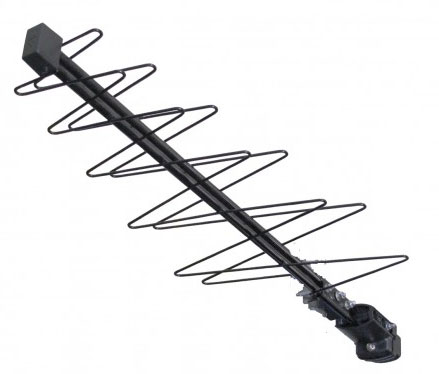 In general, if the nearest translator is 25 km - 30 km, the terrain is flat and 30-meter-long trees do not grow directly in front of the house - then the digital signal should be confident and, most likely, an outdoor antenna without an amplifier (passive) will do.
In general, if the nearest translator is 25 km - 30 km, the terrain is flat and 30-meter-long trees do not grow directly in front of the house - then the digital signal should be confident and, most likely, an outdoor antenna without an amplifier (passive) will do.
Anything that does not comply with the above conditions can be attributed to the zone of uncertain reception. For example, a house can be located in a valley, a forest can be quite close, etc. In this case, the antenna with the amplifier (active) will “help out”.
Hit 3. The excellent log-periodic antenna with the amplifier for work at average distances.
A definite plus is the power supply of 5 volts from a DVB-T2 receiver.
However, unfortunately, everything is not very good, there are always some "pitfalls". So here, acquiring an active antenna, be prepared for the fact that after a while the amplifier is likely to fail and have to be replaced. Basically, the input stage of the amplifier “crashes” due to static electricity. This can be either a discharge from induced atmospheric statics, for example, after a thunderstorm, or one that accumulates, for example, in dry, frosty weather (snow or dust is rubbing through the antenna with a stream of wind).
At first glance, it seems that the problem of the impact of static electricity on an antenna amplifier is solved quite simply - by grounding, but not at the cottage. In the conditions of the garden plot, this decision is quite ambiguous. Regular lighting protection, you see, is not so common. But there are also lightning. Serious protection against them in the country to build is absolutely impossible. In this way, grounding the antenna, located at the dominant height, you get a kind of lightning arresterin which, no matter how cool, this lightning is sure to strike, with all the ensuing consequences. Do you need it?
So it turns out that it makes no sense to make the ground for the dacha television antenna. And when a thunderstorm approaches, all electrical appliances should be disconnected from the network ( just pull the plug network cable from the outlet) - nothing more thought out. Moreover, for lightning, any antenna inserted into a TV or DVB-T2 receiver that is connected to an electrical outlet is grounded. This, too, should not be forgotten.
But back to the active antennas.
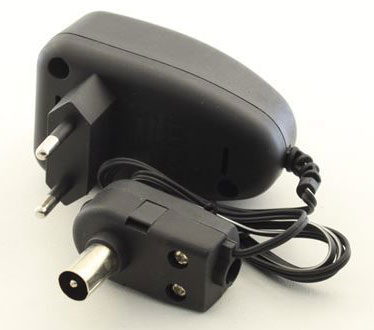 To begin with, that not so long ago, traditional, to power amplifiers of active TV antennas, was considered a voltage of 12 volts, and, accordingly, all of them were completed with a network adapter with a separator.
To begin with, that not so long ago, traditional, to power amplifiers of active TV antennas, was considered a voltage of 12 volts, and, accordingly, all of them were completed with a network adapter with a separator.
Many still believe that this is an antenna amplifier. This is absolutely not true. The amplifier is located inside the case of the most active television antenna, because it is designed to compensate for the losses in the drop cable and the splitter to several televisions, and what you plug into the electrical outlet and the antenna socket of the TV, is a normal power supply and separator.
With the advent of consoles, the amplifiers of active antennas, designed to work with these devices, have also been modified, they are designed for the supply voltage 5 volts. Almost everyone a modern digital DVB-T2 receiver is capable of providing power for such antenna amplifier without any additional network adapters.
 That's precisely because the amplifier is in the antenna itself, the process of replacing it can be difficult. After all, usually, for better reception of the signal, the antenna is quite high, so also the amplifier can be soldered, and not just mounted on screws. In any case, the antenna has to be removed entirely, and then installed back. A more convenient option, similar in characteristics to the active antenna, as it seems to me, is ordinary passive UHF antenna and amplifier installed in the cable breakso-called - mortise. They, by the way, are also on 5 and 12 volts. I absolutely consciously did not use the term "mast amplifier".
That's precisely because the amplifier is in the antenna itself, the process of replacing it can be difficult. After all, usually, for better reception of the signal, the antenna is quite high, so also the amplifier can be soldered, and not just mounted on screws. In any case, the antenna has to be removed entirely, and then installed back. A more convenient option, similar in characteristics to the active antenna, as it seems to me, is ordinary passive UHF antenna and amplifier installed in the cable breakso-called - mortise. They, by the way, are also on 5 and 12 volts. I absolutely consciously did not use the term "mast amplifier".
With this option, the amplifier can be placed in a more accessible place, for example, in the attic of a house, which will make it much easier to replace it if necessary. But here it should be noted that the length of the drop cable between the antenna and the input of the cut-in amplifier directly affects the quality of reception. Purely theoretically, it should be no more than 5-10 meters to minimize noise and losses in the cable itself, in practice, more is possible. But the length of the antenna cable from the amplifier's output to the RF (antenna) jack of the DVB-T2 receiver with a gain of about 20 dB does not matter in principle even if there is a splitter for several devices in the circuit.
Install the antenna.
Antenna for receiving a television digital television signal at the cottage can be installed on the roof of the house, on the balcony, on the attic or on the wall. Some even attach to a nearby tree, for example, when they do not want to spoil the front of the house or drill siding. But, in any case, to begin with, you should decide on the direction in which your country antenna should “look”. Naturally, it should be directed towards the nearest translator. Where he is, you can see on the website RTRS.RF. Once you have decided on the direction, you can begin the installation. For this additional may need a mast or bracket, as improvised means do not always save.
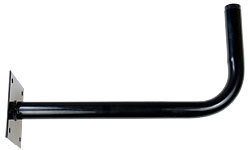 Brackets for fixing the antenna to the wall are of various lengths, the more the bracket is taken out, the larger the angle you can, if necessary, rotate the antenna. There are just situations where not one, but two or even three translators are “close”, and you don’t know exactly from which of them the signal will be received better.
Brackets for fixing the antenna to the wall are of various lengths, the more the bracket is taken out, the larger the angle you can, if necessary, rotate the antenna. There are just situations where not one, but two or even three translators are “close”, and you don’t know exactly from which of them the signal will be received better.
As for the height at which the antenna will be located, it must correspond to the surrounding conditions (mountain-lowland, terrain to the translator, etc.). Here I will advise for the most part to pay attention to the installation height of the antennas that already exist in the area, i.e. on neighboring suburban areas.
I think that about the distant reception, in its full understanding, in the case of digital television no speech, therefore it is unlikely that you will need to strive for some prohibitive antenna suspension height. By and large, everything needs to be tried, despite the fact that, naturally, the higher - the better.
To advanced users, to determine the required antenna mounting height, I can recommend familiarity with the linktest service.
As an epilogue.
Summing up everything written above about antennas for receiving terrestrial digital television in the country can be a list of recommendations:
- To receive terrestrial DVB-T2 television broadcasting, there is enough antenna that works in the UHF range. If you already have an all-wave television antenna in your dacha, then you can use it, you will hardly need another one;
- When choosing a dacha antenna and determining its directivity, the successful experience of your neighbors in the cottage will be very useful;
- A room antenna at the dacha can be used only if the area is in a zone of reliable reception within the line of sight of the translator when the level of the digital DVB-T2 signal inside the room is high enough;
- The best quality of reception of the on-air digital signal at the cottage and in the country house will be ensured by the outdoor all-wave or UHF antenna. The most effective when receiving a DVB-T2 signal showed directional antennas such as "wave channel" and log-periodic antennas. Other things being equal, it is better to choose an antenna with a large gain value and / or a smaller mass;
- A clear answer to the question - which antenna is better, active (with built-in amplifier) or passive? - does not exist. You just need to take into account that the amplifier serves only to compensate for the loss in the cable and / or splitter to several TVs, and if the antenna design itself does not take anything at all, then there will be nothing to reinforce either. The main disadvantage of active antennas is that the built-in amplifier in the absence of normal lightning protection and “competent” grounding quite often “crashes”. In the absence of any cheap dischargers, I emphasize that a reliable and, most importantly, a well-made grounding system is also unlikely to help;
- I believe that in the overwhelming majority of cases, when receiving digital TV at a dacha, it is advisable to start with an attempt to “get along” with a passive antenna, and an amplifier, if necessary, can always be purchased separately. In terms of cost, an active antenna with a built-in amplifier and, as an alternative to it, a passive antenna + an additional embedded amplifier, do not differ much. The second option is more practical, since if necessary, the plug-in amplifier can be easily replaced;
- Do not seek to purchase the most expensive antenna, absolutely not the fact that it will be better. Do not pay attention to the tempting delusional inscriptions on the antenna package and the magnificent gain of tiny “nanotechnology” devices. As a rule, behind the beautiful pictures and a set of "smart" words lies frank "trash." But on antenna cable you should not save, it should be of high quality;
- And the last thing - if the seller of the store where you choose your antenna, instead of specific questions and advice, is thrown into incomprehensible terminology, and for greater importance it talks about noises, tracts, losses, characteristics and reminds itself of a radio amateur guide, then go to another score.
In the article, I tried to use words that everyone understood and, as you may have noticed, I often write in the process of presentation - most likely, theoretically, etc. The reason for this is that, of course, there is a lot of truth in theory, but, firstly, we need to “go, not checkers”, and secondly, to assert with 100% certainty whether any single antenna can cope with Reception of the on-air digital television signal at your dacha can only be done by testing it in practice. It is enough just to carelessly or incorrectly cut the cable, and this, believe me, is often found to “kill” the reception with the most remarkable antenna, and there are so many “if” ohs. For our part, in our shop we collect statistics on the work of the equipment we sell (antennas and DVB-T2 receivers) in various districts of the Leningrad Region.
Television continues to be one of the most influential sources of information and the favorite pastime of most average people. Therefore, no one has canceled the importance of broadcast quality and, accordingly, the problem of choosing the right television antenna. Here you can make a choice in favor of a TV antenna with or without an amplifier, because this convenient device does not lose its popularity to this day.
Attention! indoor antennas DVB-T2 can be found in the section Antenna room for digital television.
Any tV antenna can be successfully used in urban apartment buildings, especially residents of the upper floors or apartments, located in direct line of sight from the telecentre - these are the best conditions for receiving a signal. True, there are in the application of such television antennas and nuances. For example, if the windows look in the opposite direction with respect to the telecentre, a very small field strength is created, therefore, it is not necessary to speak of a really high-quality reception of TV programs without an additional amplifier of a television antenna. The grilles and shading curtains will create even more barriers to the television signal, and sometimes they will not allow the program to be watched, which the usual television antenna has taken very well before.
In order to avoid such incidents, it is necessary to adhere to a simple rule: do not require the impossible from a television antenna. However, modern television antennas are increasingly powerful, sophisticated and make pleasant evenings in front of a blue screen. Moreover, this problem can be solved by using a television antenna with an amplifier. After all, a television antenna with an amplifier is a much more powerful device for transmitting a pure signal than a standard television antenna.
Indoor TV antennas with an amplifier, as a rule, are small in size, so it is worth nothing to move them from place to place. Television antennas with an amplifier come in a folding or just a compact design. Of great importance is the material from which the television antenna is made, and here the plant for the production of antennas Delta took into account all the necessary details. Of course, installing a television antenna with or without an amplifier, you should take into account all negative factors affecting the signal quality, but if you trust the experts in this matter, you will not lose and get a television antenna that suits your room and meets your requirements. In our catalog you can familiarize yourself with the characteristics of television antennas with an amplifier that interest you.
There are several types of signals and the same types of antennas:
- Digital broadcasting. A program was launched in Russia, according to which, by the end of 2015, the entire territory of the country was to be covered by digital television. This is what happened, if there is a tower distributing a TV signal near your dacha, then using a conventional UHF antenna and a set-top box with a DVB-T2 tuner, you can receive up to 20 channels in normal quality. If you have modern tvthat supports this format, then nothing but a properly directional antenna is required;
- Essential analog television implies coding of the signal and its subsequent transmission in the decimeter and meter frequency range. Such television antennas can often be found in the suburban areas. And although with them there are quite a lot of problems, their value pleases everyone. If your cottage is seasonal, then you spend most of your time on your plot, and watch TV only during bad weather, or in the evening when there is no opportunity to work. Analog antenna is an ideal option for a seasonal dacha, because several channels that such a device can catch in most cases will be fully sufficient;
- The satellite signal provides good picture quality, the number of channels can be in the hundreds, but plates for receiving the signal are quite expensive. Dachas usually require plates with a diameter of at least 90 cm, which determines their cost. - paid, and payment must be made for the year; There are also inexpensive packages that it makes sense to purchase when you appear at the dacha only occasionally. It also raises a question of preservation: if you do not live in the country house permanently, then it is necessary that no one can penetrate into the territory of the country house. In the opposite case - it is better to dismantle it during your absence (by the way, it is not the easiest process).
Find out which antenna is suitable for your problem, you can only considering a specific case. When choosing is taken into account: location (hill, plain, lowland, etc.), the presence or absence of large trees near the cottage, distance from the nearest repeater. The most important is the distance from the tower and how high you can raise the antenna (the closer and higher - the better the signal will be).
Which antenna is better for giving
If the distance from the TV tower of the nearest city is small, then an analog antenna or even a conventional wire will be enough to receive local channels. But it is best to purchase an antenna with an amplifier that can significantly improve picture quality and sound in places with a weak television signal. True, get ready for the fact that after a while the amplifier will begin to perform its task, to put it mildly, not in the best way, so you have to change it.
But even when installing an antenna with an amplifier, there are certain risks. For example, in the evening, the air is usually heavily loaded, so the picture quality may be better. In such cases, do not suffer with an analog device, spare no expense, and install a satellite dish or digital antenna.
If with satellite dish everything is clear (better quality, many channels, but high cost), the digital antenna has an important difference from analog: it can receive up to 8 video / audio signals, while the analog one accepts only a single signal. These 8 signals are fed to the digital antenna already digitized and compressed.
Attention! The most preferred antenna with aluminum, because their weight is minimal and they also resist corrosion.
Active and passive analog antennas
We have already mentioned that analog antenna with the amplifier it shows itself well in places with weak signal, but its amplifier sooner or later begins to deteriorate.
Antennas are active and passive - with and without an amplifier, respectively (need to be purchased separately). The amateur will think that, of course, it is worth buying an active antenna, but in fact they are cheaper than passive options, although they receive more channels. Their disadvantage is that boards of amplifiers of active devices often break down due to the effects of thunderstorms, as a result of which channels start to snow or disappear altogether.
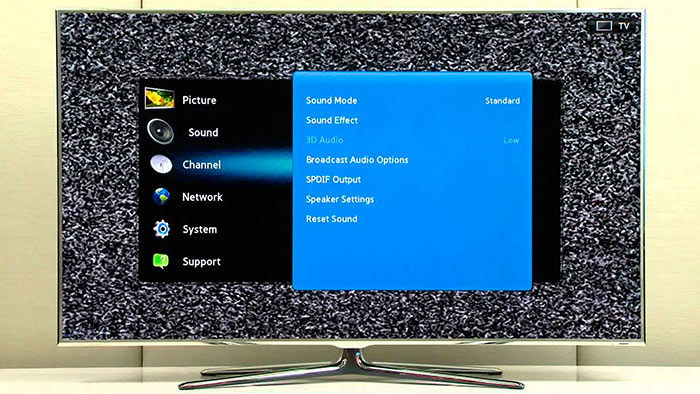
If it is not a thunderstorm, then rain after a year and a half will reduce the capabilities of the amplifier to nothing, due to the oxidation of the contacts on the board, and the problem is poor tightness. When buying, you can fill the board with silicone, as well as the place where the cable is connected. This will slow down the oxidation process, but sooner or later, the fee protected in this way will have to be changed.
Passive antennas are good because the piece of hardware itself is installed on the roof, and the amplifier is installed in the attic. Replacing the board in a passive antenna takes less time and, therefore, a headache will also be less. True, they catch a small number of channels, but the picture is always an order of magnitude cleaner. Passive antennas have two adjustments - on the UHF and MW bands, which is very useful, because some too strong signals can clog up the weaker ones, which causes sound / image overlap or starts to show a solid “snow”.
In this way, passive antennas with amplifiers located at a short distance from the TV tower is the best budget choice for summer cottage. In other cases, to get high-quality pictures and a large number of channels, you should contact digital or satellite television.
How to choose the antenna - video
Currently in Moscow DVB-T2 digital broadcasting is being broadcast on channels: 30 (multiplex 1), 24 (multiplex 2), 34 (multiplex 3. It is in test mode, some TV channels are not definitively identified) of the UHF band (see frequency grid).
On January 15, 2015, from 00:00 Moscow time, the Ostankino Tower completely stopped broadcasting the first multiplex in dVB-T standard on channel 34.
From January 2015 in Moscow and the Moscow region included the third multiplex (!) on channel 34, the programs in which are now selected on tender terms. Permanent programs 3 multiplexes are: Match! Arena, Music of the First and Life news. The list of programs that participate in the tender can be viewed.
(!) On channel 58 (770 MHz), since October 2016, a test broadcast of the ultra-high-definition signal (Ultra HD 4K) has been conducted. The signal can be received by any resident of Moscow and the nearest Moscow region if there is a TV with support for Ultra HD / DVB-T2 / HEVC.
| Multiplex 1 | Multiplex 2 | Multiplex 3 | ||
| channel 30 (546 MHz) | channel 24 (498 MHz) | channel 34 (578 MHz) | ||
| Programs | Programs | Programs | ||
| 1 channel | Ren TV | Match! Arena | ||
| Russia 1 | Saved | My Planet, Science 2.0 Fight club |
||
| Match! | STS | History, Cartoon, Russian Detective, Russian bestseller |
||
| NTV | Home | Country, Dress | ||
| 5 (Peter) | Tv 3 | Mom, 24_DOC, Amusement Park Iq hd |
||
| Russia K | Friday | Euronews, Trust | ||
| Russia 24 | Star | Music of the First | ||
| Carousel | World | L Minor, Kitchen TV, Auto Plus, India TV; HD Life, STV |
||
| OTR | TNT | LifeNews | ||
| TVC | Muz TV | Our football (temporarily coded) |
You can choose the type of receiver.
A device for the most accurate tuning of digital terrestrial (DVB-T / T2) antennas.
DVB-T2 Long Range Antennas
Balcony Antennas DVB-T2
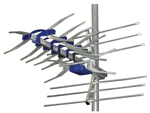 |
Antenna for reception television signals in the UHF range. Easily installed on a wall (using a bracket) or directly on the balcony grille in apartments for digital broadcasting. terrestrial television DVB-T2 standard. |

